Psychology Report: A Batak Evaluation of Goal Setting and Control
VerifiedAdded on 2023/06/10
|12
|2812
|133
Report
AI Summary
This report investigates the impact of goal setting on performance using a Batak machine experiment. Ninety-nine psychology undergraduate students participated, divided into a goal-setting group and a control group instructed to 'try their best.' The study used an independent experimental design, with participants randomly assigned to either group. The Batak machine measured the number of lit buttons hit within 30 seconds. While the t-test showed no significant difference between the groups' mean scores, the report discusses the theoretical underpinnings of goal setting, referencing Edwin Locke's goal setting theory and prior research. The report concludes by acknowledging limitations and suggesting future research directions in sports psychology and exercise environments. Desklib provides access to this and other solved assignments.
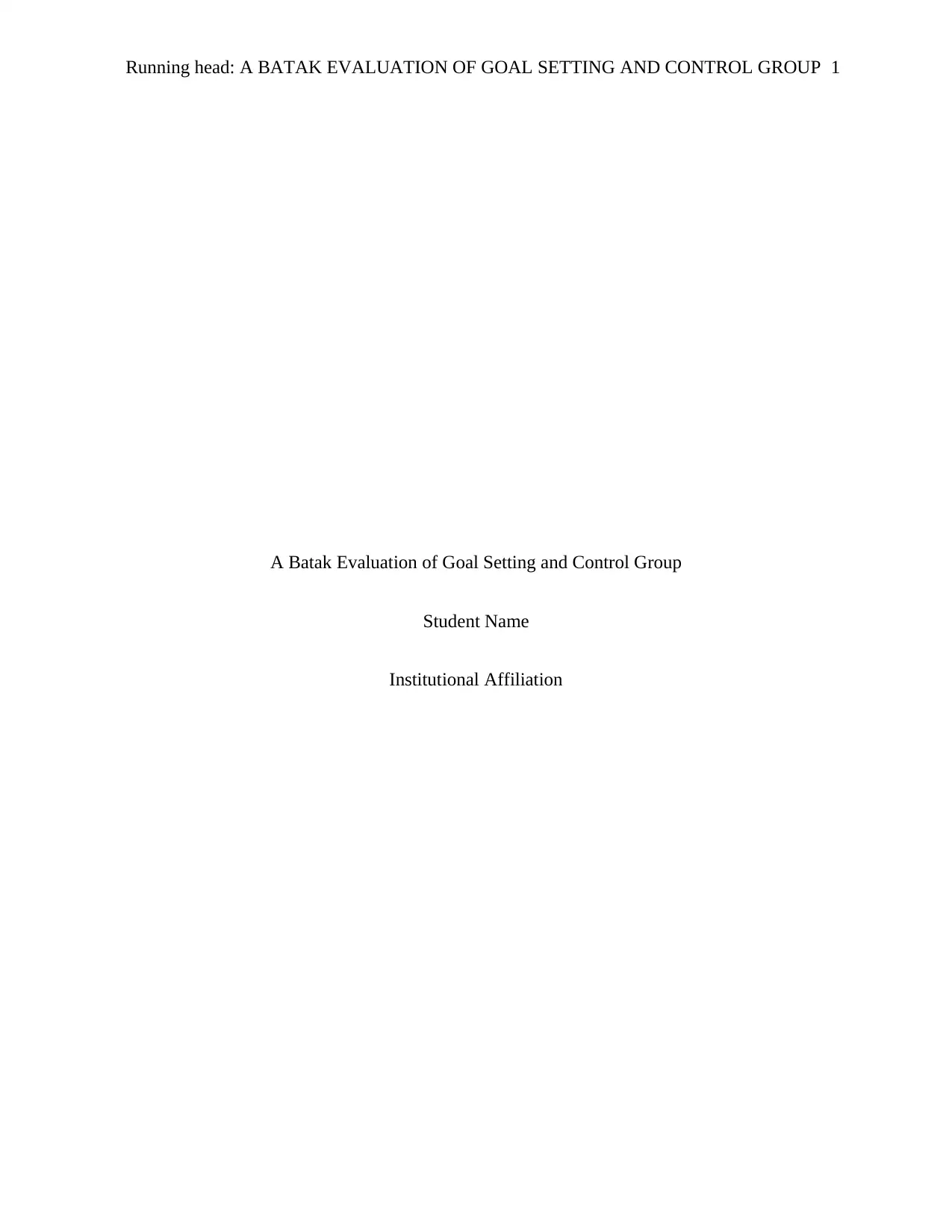
Running head: A BATAK EVALUATION OF GOAL SETTING AND CONTROL GROUP 1
A Batak Evaluation of Goal Setting and Control Group
Student Name
Institutional Affiliation
A Batak Evaluation of Goal Setting and Control Group
Student Name
Institutional Affiliation
Paraphrase This Document
Need a fresh take? Get an instant paraphrase of this document with our AI Paraphraser
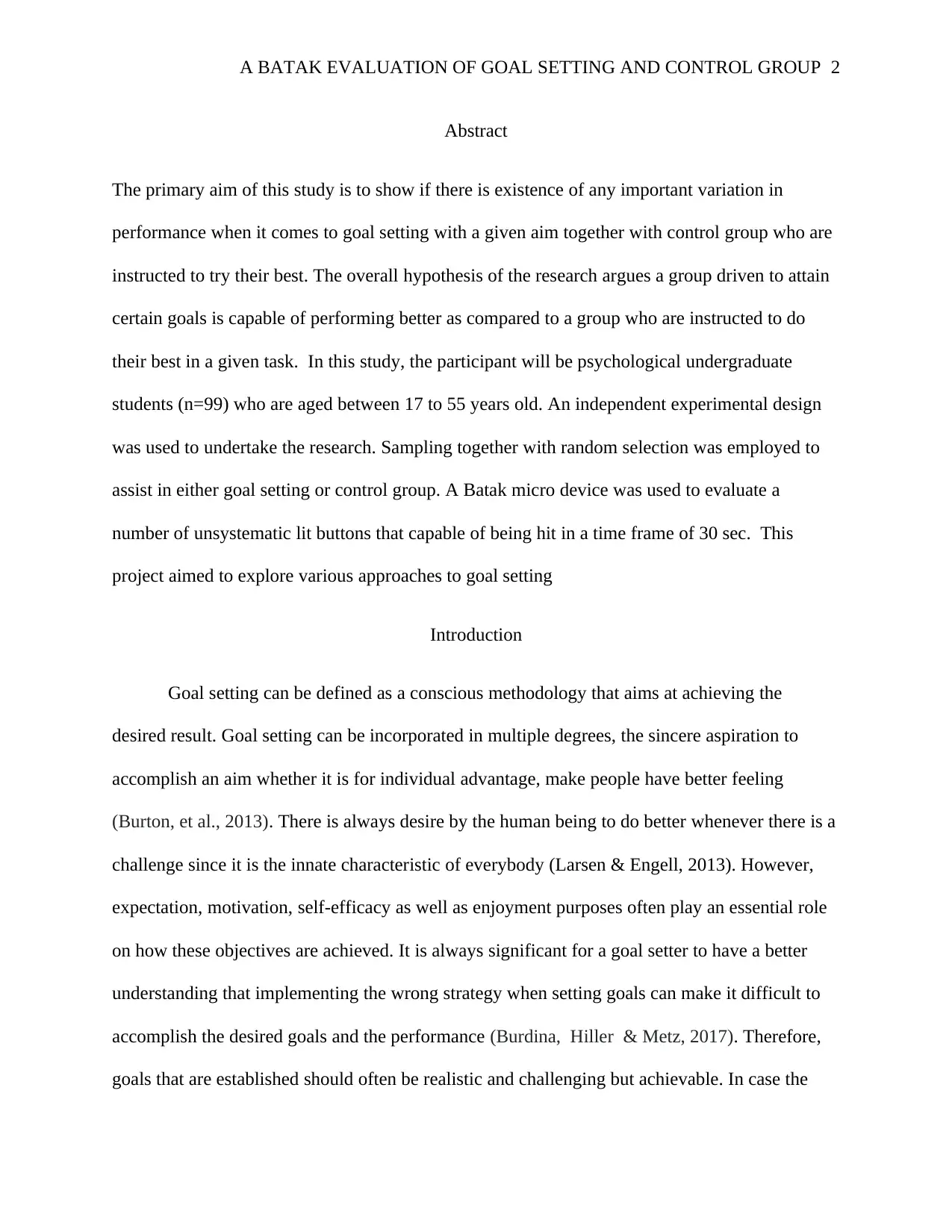
A BATAK EVALUATION OF GOAL SETTING AND CONTROL GROUP 2
Abstract
The primary aim of this study is to show if there is existence of any important variation in
performance when it comes to goal setting with a given aim together with control group who are
instructed to try their best. The overall hypothesis of the research argues a group driven to attain
certain goals is capable of performing better as compared to a group who are instructed to do
their best in a given task. In this study, the participant will be psychological undergraduate
students (n=99) who are aged between 17 to 55 years old. An independent experimental design
was used to undertake the research. Sampling together with random selection was employed to
assist in either goal setting or control group. A Batak micro device was used to evaluate a
number of unsystematic lit buttons that capable of being hit in a time frame of 30 sec. This
project aimed to explore various approaches to goal setting
Introduction
Goal setting can be defined as a conscious methodology that aims at achieving the
desired result. Goal setting can be incorporated in multiple degrees, the sincere aspiration to
accomplish an aim whether it is for individual advantage, make people have better feeling
(Burton, et al., 2013). There is always desire by the human being to do better whenever there is a
challenge since it is the innate characteristic of everybody (Larsen & Engell, 2013). However,
expectation, motivation, self-efficacy as well as enjoyment purposes often play an essential role
on how these objectives are achieved. It is always significant for a goal setter to have a better
understanding that implementing the wrong strategy when setting goals can make it difficult to
accomplish the desired goals and the performance (Burdina, Hiller & Metz, 2017). Therefore,
goals that are established should often be realistic and challenging but achievable. In case the
Abstract
The primary aim of this study is to show if there is existence of any important variation in
performance when it comes to goal setting with a given aim together with control group who are
instructed to try their best. The overall hypothesis of the research argues a group driven to attain
certain goals is capable of performing better as compared to a group who are instructed to do
their best in a given task. In this study, the participant will be psychological undergraduate
students (n=99) who are aged between 17 to 55 years old. An independent experimental design
was used to undertake the research. Sampling together with random selection was employed to
assist in either goal setting or control group. A Batak micro device was used to evaluate a
number of unsystematic lit buttons that capable of being hit in a time frame of 30 sec. This
project aimed to explore various approaches to goal setting
Introduction
Goal setting can be defined as a conscious methodology that aims at achieving the
desired result. Goal setting can be incorporated in multiple degrees, the sincere aspiration to
accomplish an aim whether it is for individual advantage, make people have better feeling
(Burton, et al., 2013). There is always desire by the human being to do better whenever there is a
challenge since it is the innate characteristic of everybody (Larsen & Engell, 2013). However,
expectation, motivation, self-efficacy as well as enjoyment purposes often play an essential role
on how these objectives are achieved. It is always significant for a goal setter to have a better
understanding that implementing the wrong strategy when setting goals can make it difficult to
accomplish the desired goals and the performance (Burdina, Hiller & Metz, 2017). Therefore,
goals that are established should often be realistic and challenging but achievable. In case the
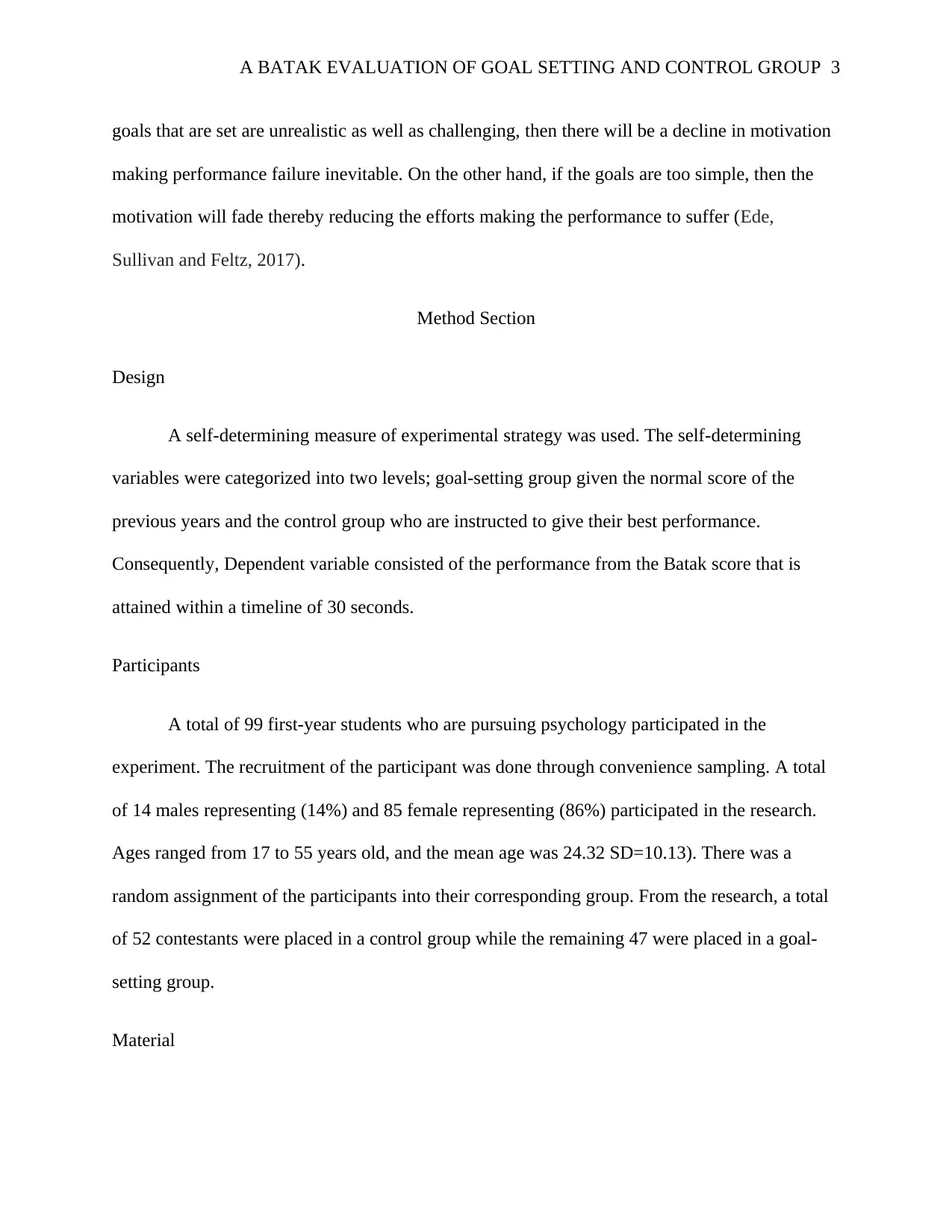
A BATAK EVALUATION OF GOAL SETTING AND CONTROL GROUP 3
goals that are set are unrealistic as well as challenging, then there will be a decline in motivation
making performance failure inevitable. On the other hand, if the goals are too simple, then the
motivation will fade thereby reducing the efforts making the performance to suffer (Ede,
Sullivan and Feltz, 2017).
Method Section
Design
A self-determining measure of experimental strategy was used. The self-determining
variables were categorized into two levels; goal-setting group given the normal score of the
previous years and the control group who are instructed to give their best performance.
Consequently, Dependent variable consisted of the performance from the Batak score that is
attained within a timeline of 30 seconds.
Participants
A total of 99 first-year students who are pursuing psychology participated in the
experiment. The recruitment of the participant was done through convenience sampling. A total
of 14 males representing (14%) and 85 female representing (86%) participated in the research.
Ages ranged from 17 to 55 years old, and the mean age was 24.32 SD=10.13). There was a
random assignment of the participants into their corresponding group. From the research, a total
of 52 contestants were placed in a control group while the remaining 47 were placed in a goal-
setting group.
Material
goals that are set are unrealistic as well as challenging, then there will be a decline in motivation
making performance failure inevitable. On the other hand, if the goals are too simple, then the
motivation will fade thereby reducing the efforts making the performance to suffer (Ede,
Sullivan and Feltz, 2017).
Method Section
Design
A self-determining measure of experimental strategy was used. The self-determining
variables were categorized into two levels; goal-setting group given the normal score of the
previous years and the control group who are instructed to give their best performance.
Consequently, Dependent variable consisted of the performance from the Batak score that is
attained within a timeline of 30 seconds.
Participants
A total of 99 first-year students who are pursuing psychology participated in the
experiment. The recruitment of the participant was done through convenience sampling. A total
of 14 males representing (14%) and 85 female representing (86%) participated in the research.
Ages ranged from 17 to 55 years old, and the mean age was 24.32 SD=10.13). There was a
random assignment of the participants into their corresponding group. From the research, a total
of 52 contestants were placed in a control group while the remaining 47 were placed in a goal-
setting group.
Material
⊘ This is a preview!⊘
Do you want full access?
Subscribe today to unlock all pages.

Trusted by 1+ million students worldwide
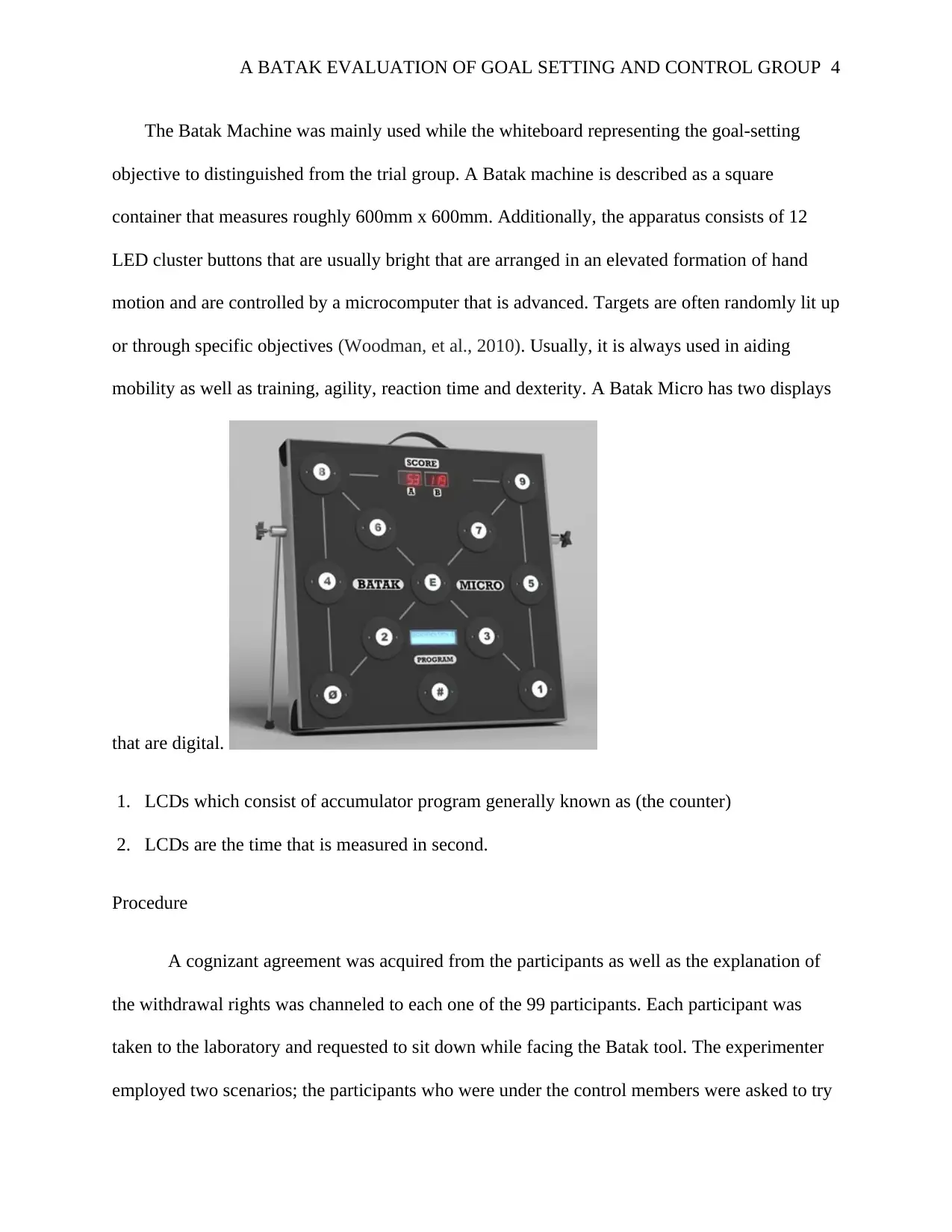
A BATAK EVALUATION OF GOAL SETTING AND CONTROL GROUP 4
The Batak Machine was mainly used while the whiteboard representing the goal-setting
objective to distinguished from the trial group. A Batak machine is described as a square
container that measures roughly 600mm x 600mm. Additionally, the apparatus consists of 12
LED cluster buttons that are usually bright that are arranged in an elevated formation of hand
motion and are controlled by a microcomputer that is advanced. Targets are often randomly lit up
or through specific objectives (Woodman, et al., 2010). Usually, it is always used in aiding
mobility as well as training, agility, reaction time and dexterity. A Batak Micro has two displays
that are digital.
1. LCDs which consist of accumulator program generally known as (the counter)
2. LCDs are the time that is measured in second.
Procedure
A cognizant agreement was acquired from the participants as well as the explanation of
the withdrawal rights was channeled to each one of the 99 participants. Each participant was
taken to the laboratory and requested to sit down while facing the Batak tool. The experimenter
employed two scenarios; the participants who were under the control members were asked to try
The Batak Machine was mainly used while the whiteboard representing the goal-setting
objective to distinguished from the trial group. A Batak machine is described as a square
container that measures roughly 600mm x 600mm. Additionally, the apparatus consists of 12
LED cluster buttons that are usually bright that are arranged in an elevated formation of hand
motion and are controlled by a microcomputer that is advanced. Targets are often randomly lit up
or through specific objectives (Woodman, et al., 2010). Usually, it is always used in aiding
mobility as well as training, agility, reaction time and dexterity. A Batak Micro has two displays
that are digital.
1. LCDs which consist of accumulator program generally known as (the counter)
2. LCDs are the time that is measured in second.
Procedure
A cognizant agreement was acquired from the participants as well as the explanation of
the withdrawal rights was channeled to each one of the 99 participants. Each participant was
taken to the laboratory and requested to sit down while facing the Batak tool. The experimenter
employed two scenarios; the participants who were under the control members were asked to try
Paraphrase This Document
Need a fresh take? Get an instant paraphrase of this document with our AI Paraphraser
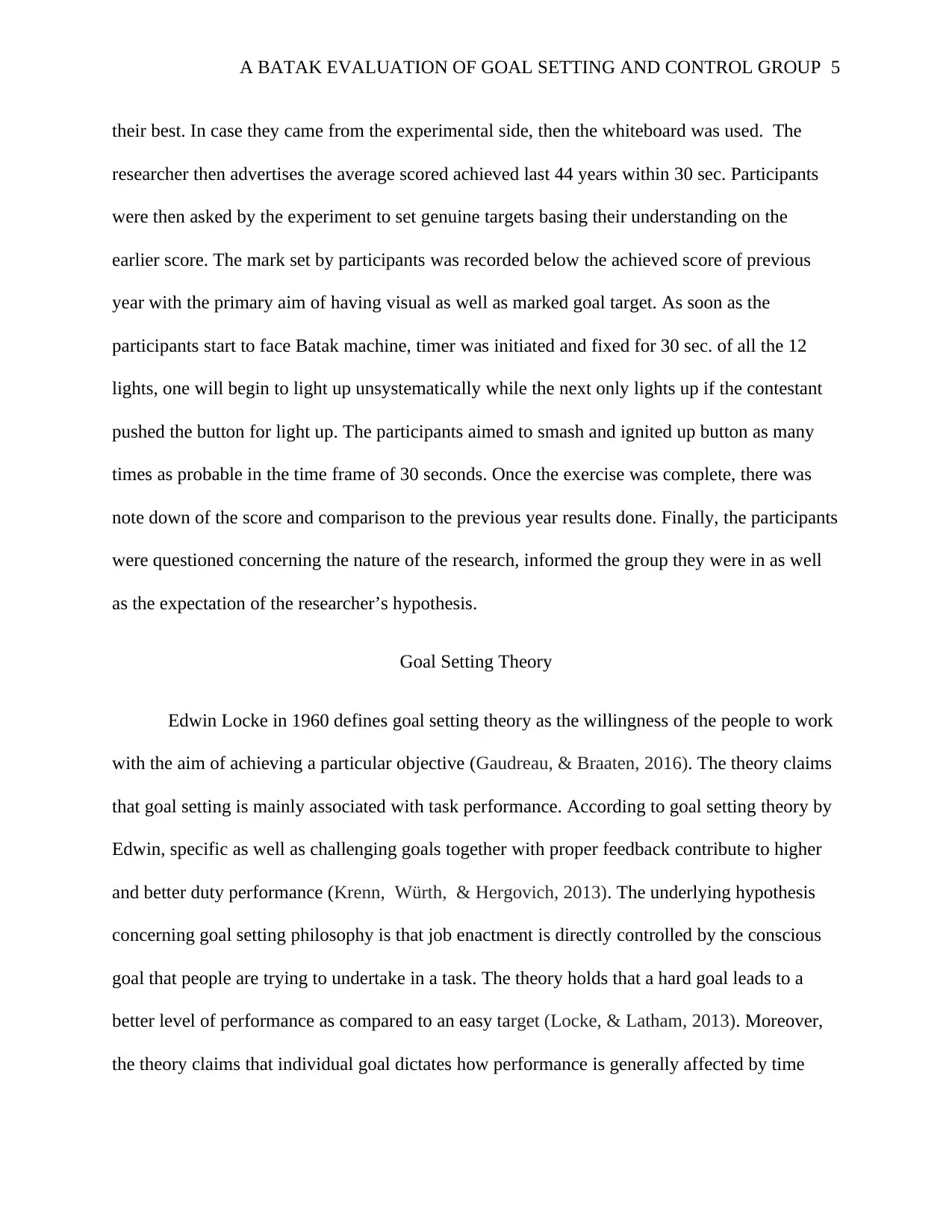
A BATAK EVALUATION OF GOAL SETTING AND CONTROL GROUP 5
their best. In case they came from the experimental side, then the whiteboard was used. The
researcher then advertises the average scored achieved last 44 years within 30 sec. Participants
were then asked by the experiment to set genuine targets basing their understanding on the
earlier score. The mark set by participants was recorded below the achieved score of previous
year with the primary aim of having visual as well as marked goal target. As soon as the
participants start to face Batak machine, timer was initiated and fixed for 30 sec. of all the 12
lights, one will begin to light up unsystematically while the next only lights up if the contestant
pushed the button for light up. The participants aimed to smash and ignited up button as many
times as probable in the time frame of 30 seconds. Once the exercise was complete, there was
note down of the score and comparison to the previous year results done. Finally, the participants
were questioned concerning the nature of the research, informed the group they were in as well
as the expectation of the researcher’s hypothesis.
Goal Setting Theory
Edwin Locke in 1960 defines goal setting theory as the willingness of the people to work
with the aim of achieving a particular objective (Gaudreau, & Braaten, 2016). The theory claims
that goal setting is mainly associated with task performance. According to goal setting theory by
Edwin, specific as well as challenging goals together with proper feedback contribute to higher
and better duty performance (Krenn, Würth, & Hergovich, 2013). The underlying hypothesis
concerning goal setting philosophy is that job enactment is directly controlled by the conscious
goal that people are trying to undertake in a task. The theory holds that a hard goal leads to a
better level of performance as compared to an easy target (Locke, & Latham, 2013). Moreover,
the theory claims that individual goal dictates how performance is generally affected by time
their best. In case they came from the experimental side, then the whiteboard was used. The
researcher then advertises the average scored achieved last 44 years within 30 sec. Participants
were then asked by the experiment to set genuine targets basing their understanding on the
earlier score. The mark set by participants was recorded below the achieved score of previous
year with the primary aim of having visual as well as marked goal target. As soon as the
participants start to face Batak machine, timer was initiated and fixed for 30 sec. of all the 12
lights, one will begin to light up unsystematically while the next only lights up if the contestant
pushed the button for light up. The participants aimed to smash and ignited up button as many
times as probable in the time frame of 30 seconds. Once the exercise was complete, there was
note down of the score and comparison to the previous year results done. Finally, the participants
were questioned concerning the nature of the research, informed the group they were in as well
as the expectation of the researcher’s hypothesis.
Goal Setting Theory
Edwin Locke in 1960 defines goal setting theory as the willingness of the people to work
with the aim of achieving a particular objective (Gaudreau, & Braaten, 2016). The theory claims
that goal setting is mainly associated with task performance. According to goal setting theory by
Edwin, specific as well as challenging goals together with proper feedback contribute to higher
and better duty performance (Krenn, Würth, & Hergovich, 2013). The underlying hypothesis
concerning goal setting philosophy is that job enactment is directly controlled by the conscious
goal that people are trying to undertake in a task. The theory holds that a hard goal leads to a
better level of performance as compared to an easy target (Locke, & Latham, 2013). Moreover,
the theory claims that individual goal dictates how performance is generally affected by time
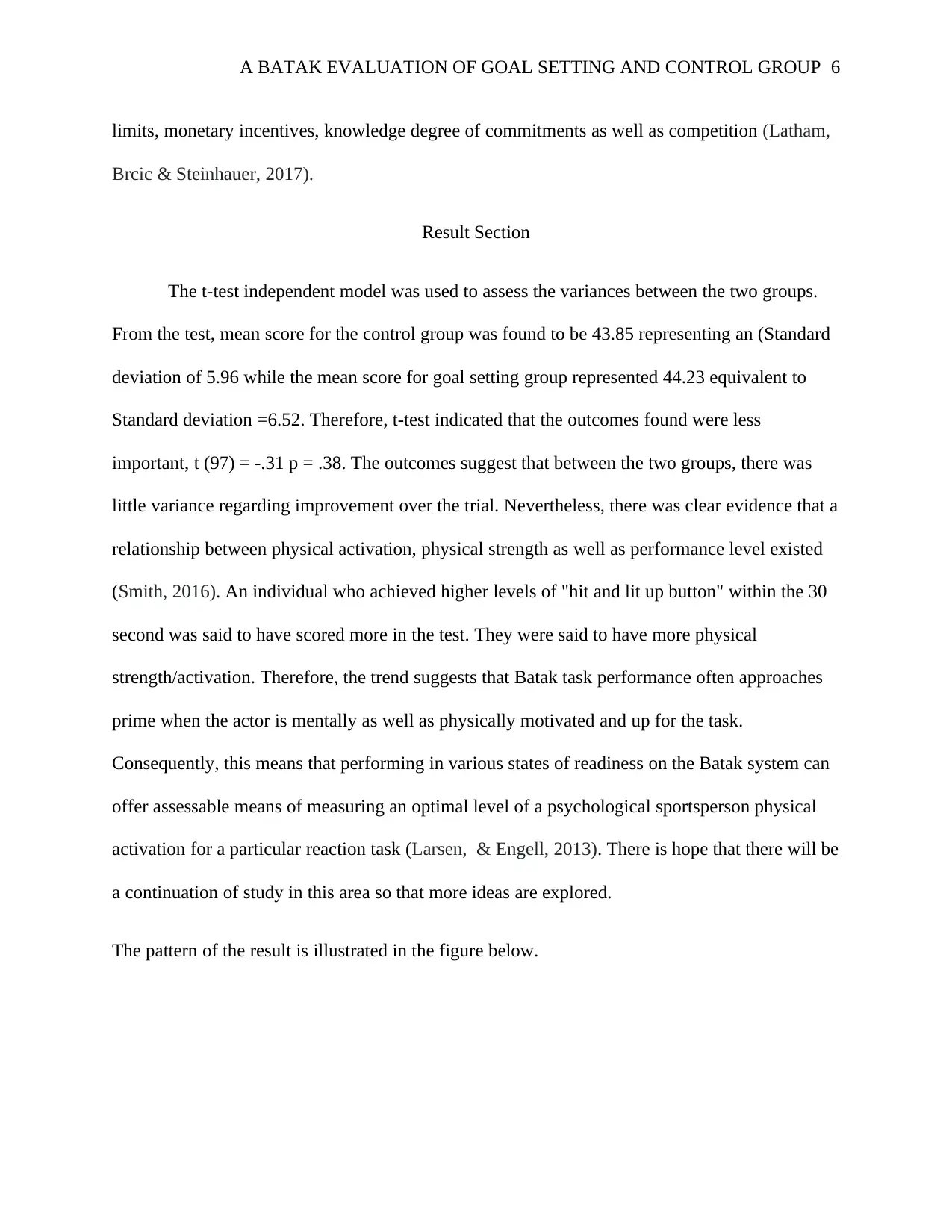
A BATAK EVALUATION OF GOAL SETTING AND CONTROL GROUP 6
limits, monetary incentives, knowledge degree of commitments as well as competition (Latham,
Brcic & Steinhauer, 2017).
Result Section
The t-test independent model was used to assess the variances between the two groups.
From the test, mean score for the control group was found to be 43.85 representing an (Standard
deviation of 5.96 while the mean score for goal setting group represented 44.23 equivalent to
Standard deviation =6.52. Therefore, t-test indicated that the outcomes found were less
important, t (97) = -.31 p = .38. The outcomes suggest that between the two groups, there was
little variance regarding improvement over the trial. Nevertheless, there was clear evidence that a
relationship between physical activation, physical strength as well as performance level existed
(Smith, 2016). An individual who achieved higher levels of "hit and lit up button" within the 30
second was said to have scored more in the test. They were said to have more physical
strength/activation. Therefore, the trend suggests that Batak task performance often approaches
prime when the actor is mentally as well as physically motivated and up for the task.
Consequently, this means that performing in various states of readiness on the Batak system can
offer assessable means of measuring an optimal level of a psychological sportsperson physical
activation for a particular reaction task (Larsen, & Engell, 2013). There is hope that there will be
a continuation of study in this area so that more ideas are explored.
The pattern of the result is illustrated in the figure below.
limits, monetary incentives, knowledge degree of commitments as well as competition (Latham,
Brcic & Steinhauer, 2017).
Result Section
The t-test independent model was used to assess the variances between the two groups.
From the test, mean score for the control group was found to be 43.85 representing an (Standard
deviation of 5.96 while the mean score for goal setting group represented 44.23 equivalent to
Standard deviation =6.52. Therefore, t-test indicated that the outcomes found were less
important, t (97) = -.31 p = .38. The outcomes suggest that between the two groups, there was
little variance regarding improvement over the trial. Nevertheless, there was clear evidence that a
relationship between physical activation, physical strength as well as performance level existed
(Smith, 2016). An individual who achieved higher levels of "hit and lit up button" within the 30
second was said to have scored more in the test. They were said to have more physical
strength/activation. Therefore, the trend suggests that Batak task performance often approaches
prime when the actor is mentally as well as physically motivated and up for the task.
Consequently, this means that performing in various states of readiness on the Batak system can
offer assessable means of measuring an optimal level of a psychological sportsperson physical
activation for a particular reaction task (Larsen, & Engell, 2013). There is hope that there will be
a continuation of study in this area so that more ideas are explored.
The pattern of the result is illustrated in the figure below.
⊘ This is a preview!⊘
Do you want full access?
Subscribe today to unlock all pages.

Trusted by 1+ million students worldwide
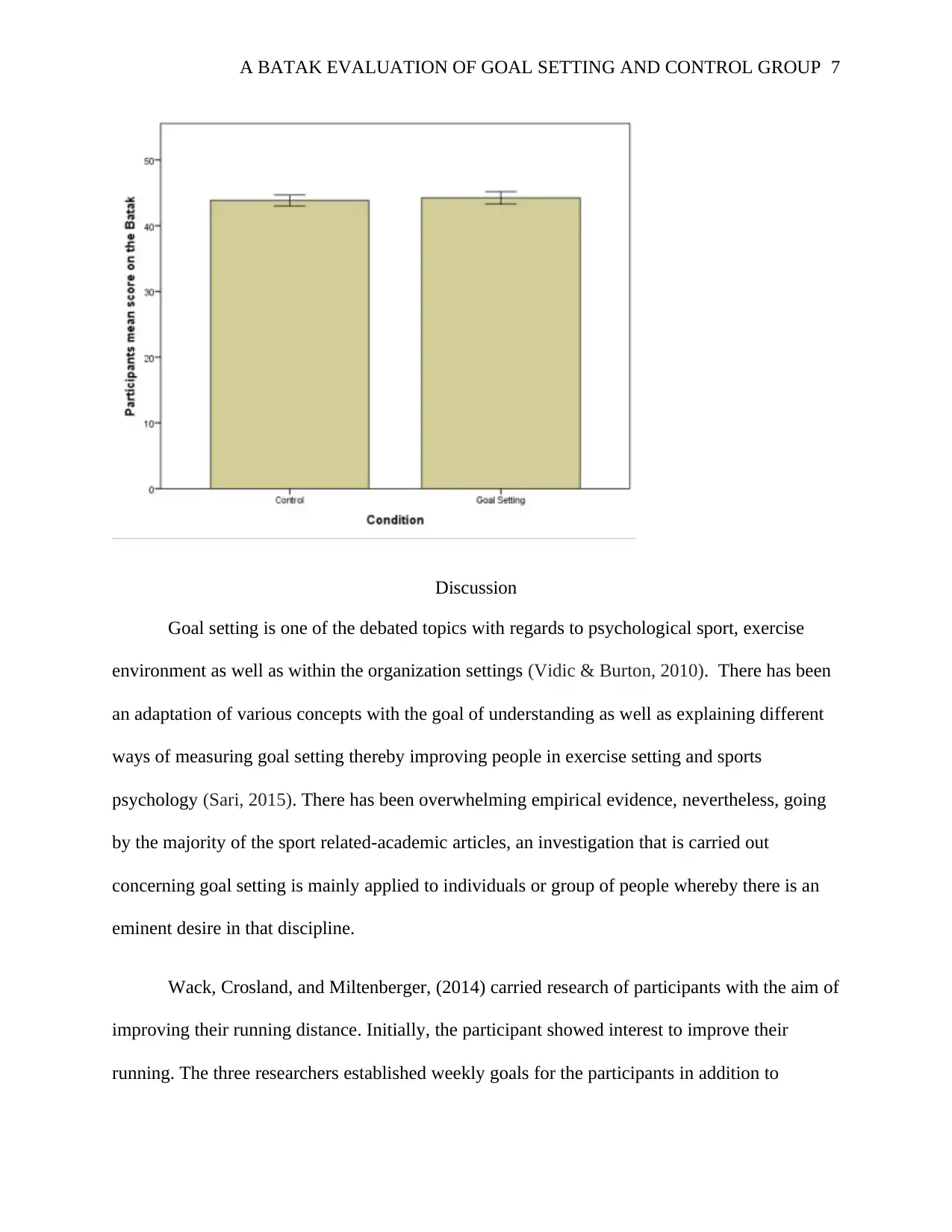
A BATAK EVALUATION OF GOAL SETTING AND CONTROL GROUP 7
Discussion
Goal setting is one of the debated topics with regards to psychological sport, exercise
environment as well as within the organization settings (Vidic & Burton, 2010). There has been
an adaptation of various concepts with the goal of understanding as well as explaining different
ways of measuring goal setting thereby improving people in exercise setting and sports
psychology (Sari, 2015). There has been overwhelming empirical evidence, nevertheless, going
by the majority of the sport related-academic articles, an investigation that is carried out
concerning goal setting is mainly applied to individuals or group of people whereby there is an
eminent desire in that discipline.
Wack, Crosland, and Miltenberger, (2014) carried research of participants with the aim of
improving their running distance. Initially, the participant showed interest to improve their
running. The three researchers established weekly goals for the participants in addition to
Discussion
Goal setting is one of the debated topics with regards to psychological sport, exercise
environment as well as within the organization settings (Vidic & Burton, 2010). There has been
an adaptation of various concepts with the goal of understanding as well as explaining different
ways of measuring goal setting thereby improving people in exercise setting and sports
psychology (Sari, 2015). There has been overwhelming empirical evidence, nevertheless, going
by the majority of the sport related-academic articles, an investigation that is carried out
concerning goal setting is mainly applied to individuals or group of people whereby there is an
eminent desire in that discipline.
Wack, Crosland, and Miltenberger, (2014) carried research of participants with the aim of
improving their running distance. Initially, the participant showed interest to improve their
running. The three researchers established weekly goals for the participants in addition to
Paraphrase This Document
Need a fresh take? Get an instant paraphrase of this document with our AI Paraphraser
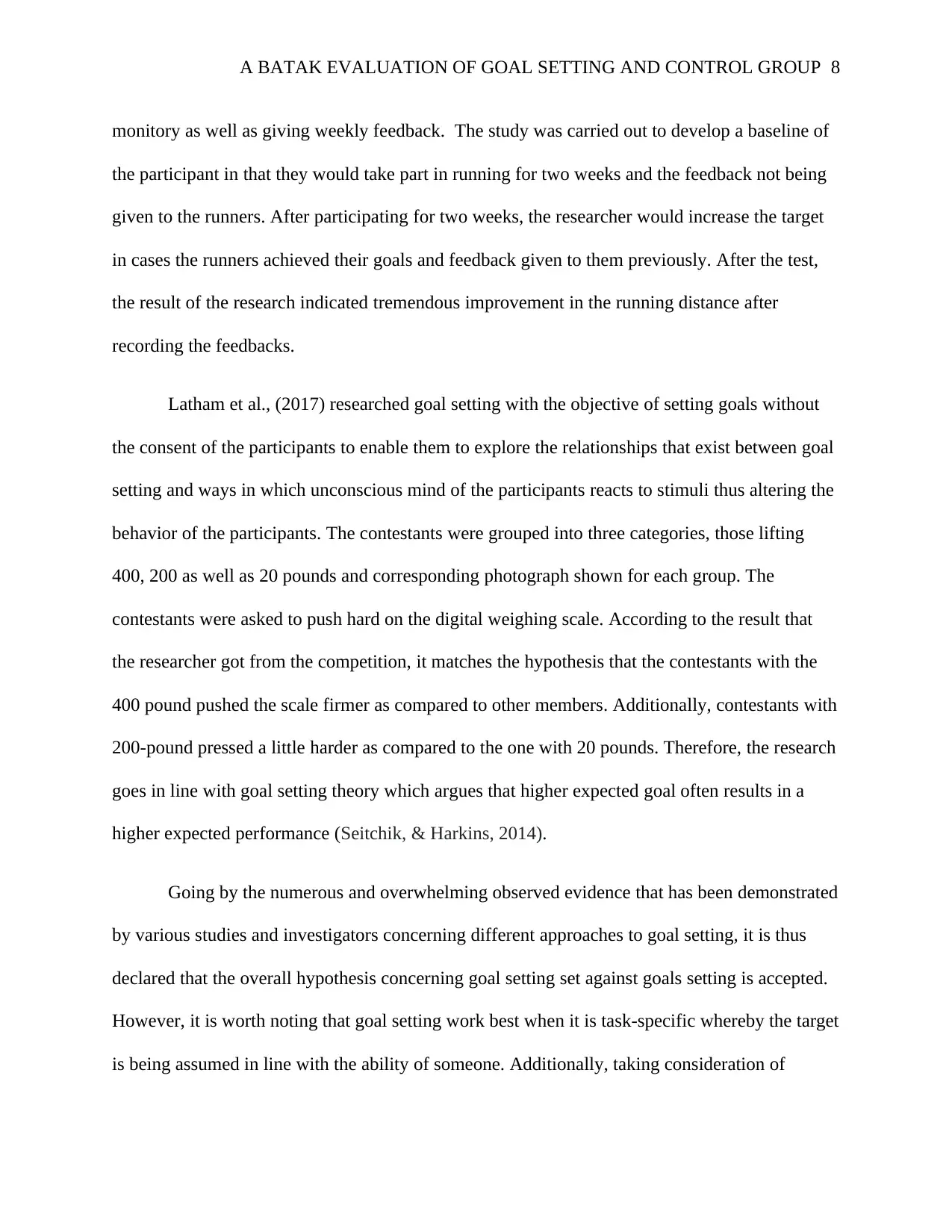
A BATAK EVALUATION OF GOAL SETTING AND CONTROL GROUP 8
monitory as well as giving weekly feedback. The study was carried out to develop a baseline of
the participant in that they would take part in running for two weeks and the feedback not being
given to the runners. After participating for two weeks, the researcher would increase the target
in cases the runners achieved their goals and feedback given to them previously. After the test,
the result of the research indicated tremendous improvement in the running distance after
recording the feedbacks.
Latham et al., (2017) researched goal setting with the objective of setting goals without
the consent of the participants to enable them to explore the relationships that exist between goal
setting and ways in which unconscious mind of the participants reacts to stimuli thus altering the
behavior of the participants. The contestants were grouped into three categories, those lifting
400, 200 as well as 20 pounds and corresponding photograph shown for each group. The
contestants were asked to push hard on the digital weighing scale. According to the result that
the researcher got from the competition, it matches the hypothesis that the contestants with the
400 pound pushed the scale firmer as compared to other members. Additionally, contestants with
200-pound pressed a little harder as compared to the one with 20 pounds. Therefore, the research
goes in line with goal setting theory which argues that higher expected goal often results in a
higher expected performance (Seitchik, & Harkins, 2014).
Going by the numerous and overwhelming observed evidence that has been demonstrated
by various studies and investigators concerning different approaches to goal setting, it is thus
declared that the overall hypothesis concerning goal setting set against goals setting is accepted.
However, it is worth noting that goal setting work best when it is task-specific whereby the target
is being assumed in line with the ability of someone. Additionally, taking consideration of
monitory as well as giving weekly feedback. The study was carried out to develop a baseline of
the participant in that they would take part in running for two weeks and the feedback not being
given to the runners. After participating for two weeks, the researcher would increase the target
in cases the runners achieved their goals and feedback given to them previously. After the test,
the result of the research indicated tremendous improvement in the running distance after
recording the feedbacks.
Latham et al., (2017) researched goal setting with the objective of setting goals without
the consent of the participants to enable them to explore the relationships that exist between goal
setting and ways in which unconscious mind of the participants reacts to stimuli thus altering the
behavior of the participants. The contestants were grouped into three categories, those lifting
400, 200 as well as 20 pounds and corresponding photograph shown for each group. The
contestants were asked to push hard on the digital weighing scale. According to the result that
the researcher got from the competition, it matches the hypothesis that the contestants with the
400 pound pushed the scale firmer as compared to other members. Additionally, contestants with
200-pound pressed a little harder as compared to the one with 20 pounds. Therefore, the research
goes in line with goal setting theory which argues that higher expected goal often results in a
higher expected performance (Seitchik, & Harkins, 2014).
Going by the numerous and overwhelming observed evidence that has been demonstrated
by various studies and investigators concerning different approaches to goal setting, it is thus
declared that the overall hypothesis concerning goal setting set against goals setting is accepted.
However, it is worth noting that goal setting work best when it is task-specific whereby the target
is being assumed in line with the ability of someone. Additionally, taking consideration of
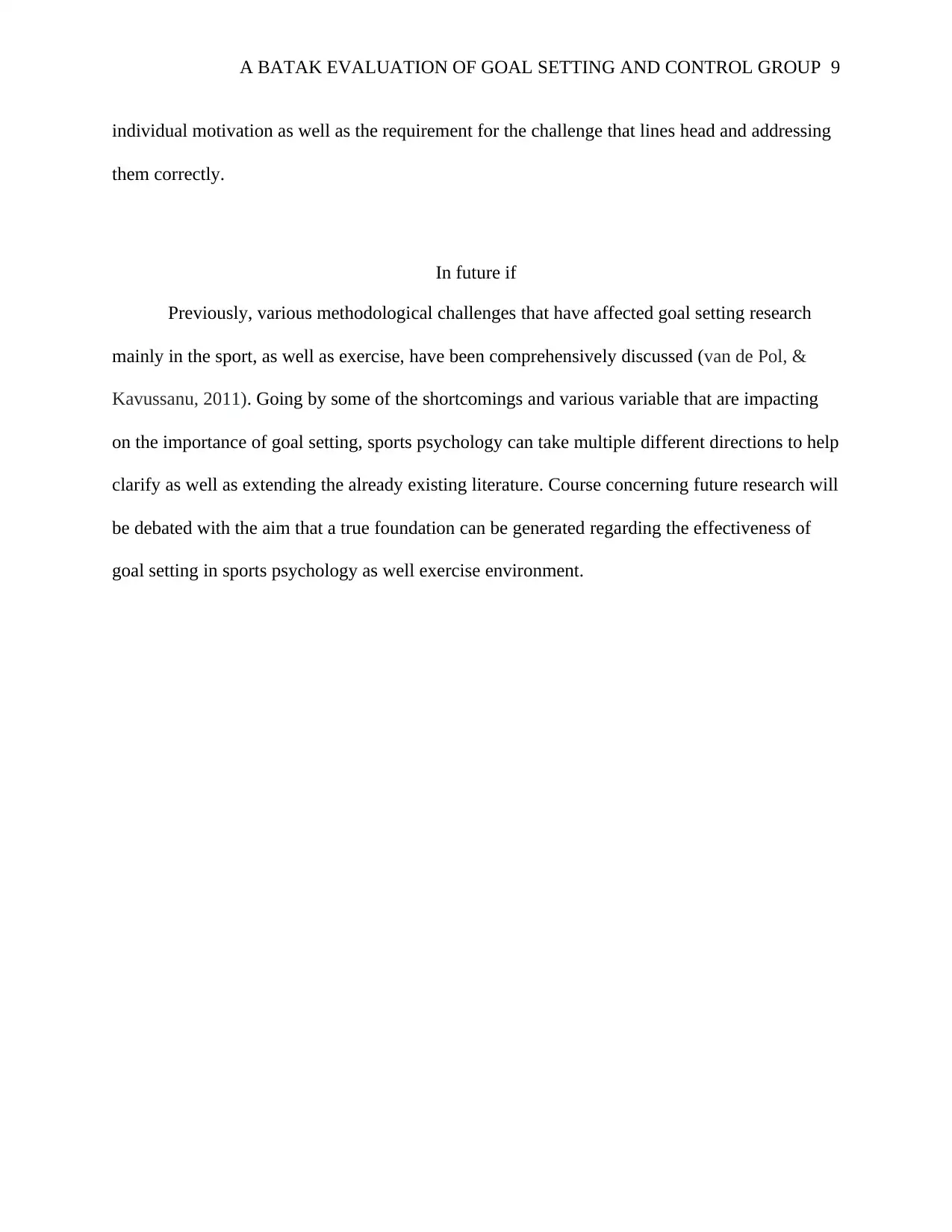
A BATAK EVALUATION OF GOAL SETTING AND CONTROL GROUP 9
individual motivation as well as the requirement for the challenge that lines head and addressing
them correctly.
In future if
Previously, various methodological challenges that have affected goal setting research
mainly in the sport, as well as exercise, have been comprehensively discussed (van de Pol, &
Kavussanu, 2011). Going by some of the shortcomings and various variable that are impacting
on the importance of goal setting, sports psychology can take multiple different directions to help
clarify as well as extending the already existing literature. Course concerning future research will
be debated with the aim that a true foundation can be generated regarding the effectiveness of
goal setting in sports psychology as well exercise environment.
individual motivation as well as the requirement for the challenge that lines head and addressing
them correctly.
In future if
Previously, various methodological challenges that have affected goal setting research
mainly in the sport, as well as exercise, have been comprehensively discussed (van de Pol, &
Kavussanu, 2011). Going by some of the shortcomings and various variable that are impacting
on the importance of goal setting, sports psychology can take multiple different directions to help
clarify as well as extending the already existing literature. Course concerning future research will
be debated with the aim that a true foundation can be generated regarding the effectiveness of
goal setting in sports psychology as well exercise environment.
⊘ This is a preview!⊘
Do you want full access?
Subscribe today to unlock all pages.

Trusted by 1+ million students worldwide
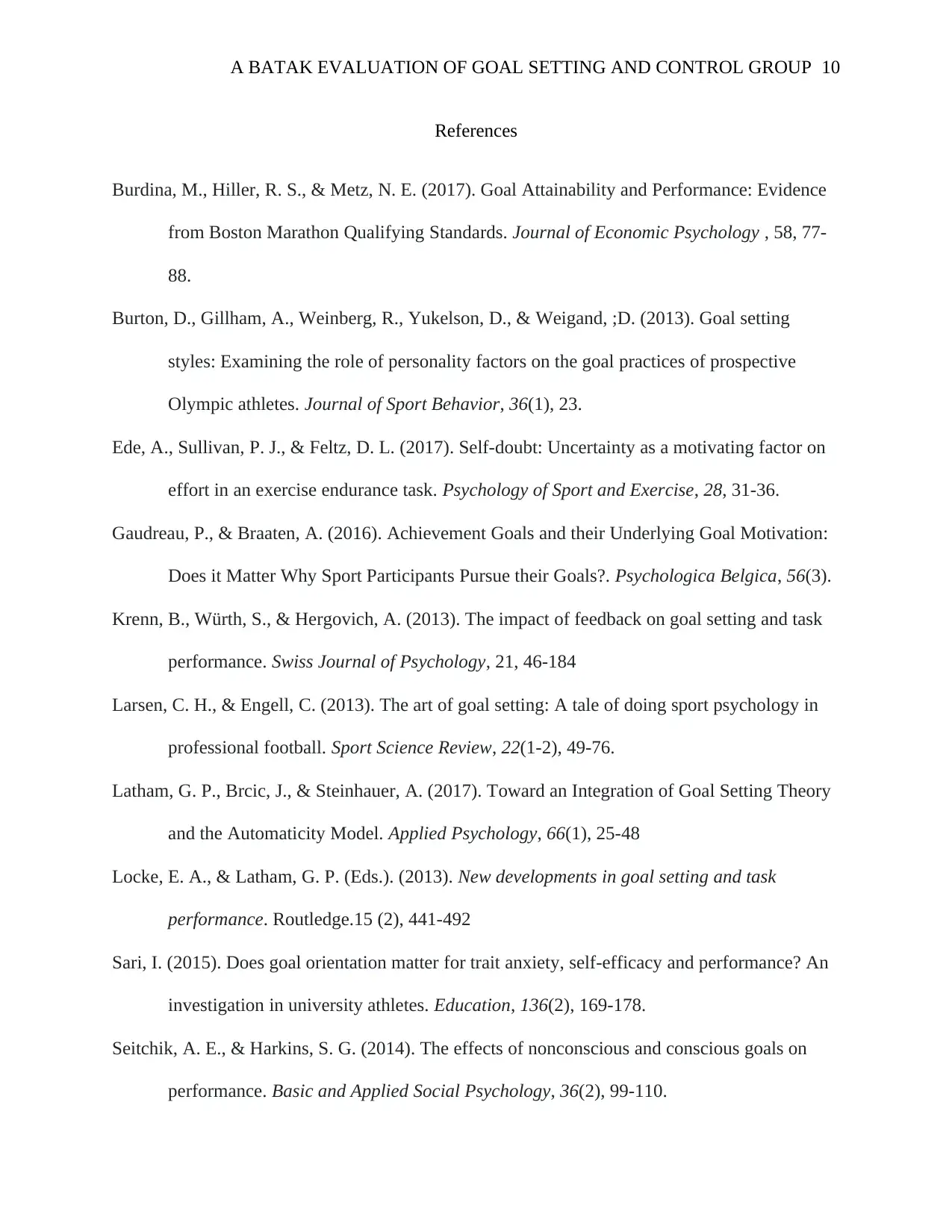
A BATAK EVALUATION OF GOAL SETTING AND CONTROL GROUP 10
References
Burdina, M., Hiller, R. S., & Metz, N. E. (2017). Goal Attainability and Performance: Evidence
from Boston Marathon Qualifying Standards. Journal of Economic Psychology , 58, 77-
88.
Burton, D., Gillham, A., Weinberg, R., Yukelson, D., & Weigand, ;D. (2013). Goal setting
styles: Examining the role of personality factors on the goal practices of prospective
Olympic athletes. Journal of Sport Behavior, 36(1), 23.
Ede, A., Sullivan, P. J., & Feltz, D. L. (2017). Self-doubt: Uncertainty as a motivating factor on
effort in an exercise endurance task. Psychology of Sport and Exercise, 28, 31-36.
Gaudreau, P., & Braaten, A. (2016). Achievement Goals and their Underlying Goal Motivation:
Does it Matter Why Sport Participants Pursue their Goals?. Psychologica Belgica, 56(3).
Krenn, B., Würth, S., & Hergovich, A. (2013). The impact of feedback on goal setting and task
performance. Swiss Journal of Psychology, 21, 46-184
Larsen, C. H., & Engell, C. (2013). The art of goal setting: A tale of doing sport psychology in
professional football. Sport Science Review, 22(1-2), 49-76.
Latham, G. P., Brcic, J., & Steinhauer, A. (2017). Toward an Integration of Goal Setting Theory
and the Automaticity Model. Applied Psychology, 66(1), 25-48
Locke, E. A., & Latham, G. P. (Eds.). (2013). New developments in goal setting and task
performance. Routledge.15 (2), 441-492
Sari, I. (2015). Does goal orientation matter for trait anxiety, self-efficacy and performance? An
investigation in university athletes. Education, 136(2), 169-178.
Seitchik, A. E., & Harkins, S. G. (2014). The effects of nonconscious and conscious goals on
performance. Basic and Applied Social Psychology, 36(2), 99-110.
References
Burdina, M., Hiller, R. S., & Metz, N. E. (2017). Goal Attainability and Performance: Evidence
from Boston Marathon Qualifying Standards. Journal of Economic Psychology , 58, 77-
88.
Burton, D., Gillham, A., Weinberg, R., Yukelson, D., & Weigand, ;D. (2013). Goal setting
styles: Examining the role of personality factors on the goal practices of prospective
Olympic athletes. Journal of Sport Behavior, 36(1), 23.
Ede, A., Sullivan, P. J., & Feltz, D. L. (2017). Self-doubt: Uncertainty as a motivating factor on
effort in an exercise endurance task. Psychology of Sport and Exercise, 28, 31-36.
Gaudreau, P., & Braaten, A. (2016). Achievement Goals and their Underlying Goal Motivation:
Does it Matter Why Sport Participants Pursue their Goals?. Psychologica Belgica, 56(3).
Krenn, B., Würth, S., & Hergovich, A. (2013). The impact of feedback on goal setting and task
performance. Swiss Journal of Psychology, 21, 46-184
Larsen, C. H., & Engell, C. (2013). The art of goal setting: A tale of doing sport psychology in
professional football. Sport Science Review, 22(1-2), 49-76.
Latham, G. P., Brcic, J., & Steinhauer, A. (2017). Toward an Integration of Goal Setting Theory
and the Automaticity Model. Applied Psychology, 66(1), 25-48
Locke, E. A., & Latham, G. P. (Eds.). (2013). New developments in goal setting and task
performance. Routledge.15 (2), 441-492
Sari, I. (2015). Does goal orientation matter for trait anxiety, self-efficacy and performance? An
investigation in university athletes. Education, 136(2), 169-178.
Seitchik, A. E., & Harkins, S. G. (2014). The effects of nonconscious and conscious goals on
performance. Basic and Applied Social Psychology, 36(2), 99-110.
Paraphrase This Document
Need a fresh take? Get an instant paraphrase of this document with our AI Paraphraser
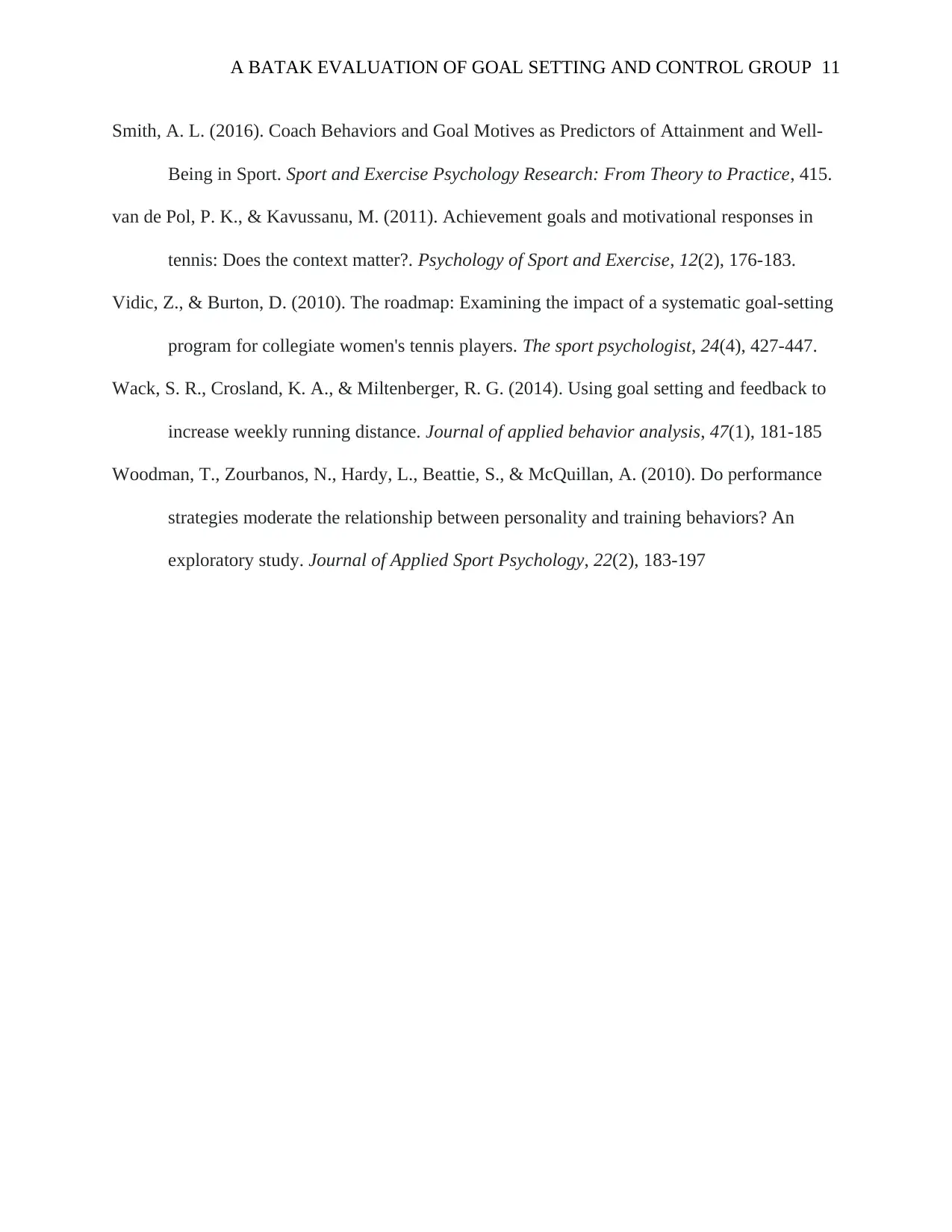
A BATAK EVALUATION OF GOAL SETTING AND CONTROL GROUP 11
Smith, A. L. (2016). Coach Behaviors and Goal Motives as Predictors of Attainment and Well-
Being in Sport. Sport and Exercise Psychology Research: From Theory to Practice, 415.
van de Pol, P. K., & Kavussanu, M. (2011). Achievement goals and motivational responses in
tennis: Does the context matter?. Psychology of Sport and Exercise, 12(2), 176-183.
Vidic, Z., & Burton, D. (2010). The roadmap: Examining the impact of a systematic goal-setting
program for collegiate women's tennis players. The sport psychologist, 24(4), 427-447.
Wack, S. R., Crosland, K. A., & Miltenberger, R. G. (2014). Using goal setting and feedback to
increase weekly running distance. Journal of applied behavior analysis, 47(1), 181-185
Woodman, T., Zourbanos, N., Hardy, L., Beattie, S., & McQuillan, A. (2010). Do performance
strategies moderate the relationship between personality and training behaviors? An
exploratory study. Journal of Applied Sport Psychology, 22(2), 183-197
Smith, A. L. (2016). Coach Behaviors and Goal Motives as Predictors of Attainment and Well-
Being in Sport. Sport and Exercise Psychology Research: From Theory to Practice, 415.
van de Pol, P. K., & Kavussanu, M. (2011). Achievement goals and motivational responses in
tennis: Does the context matter?. Psychology of Sport and Exercise, 12(2), 176-183.
Vidic, Z., & Burton, D. (2010). The roadmap: Examining the impact of a systematic goal-setting
program for collegiate women's tennis players. The sport psychologist, 24(4), 427-447.
Wack, S. R., Crosland, K. A., & Miltenberger, R. G. (2014). Using goal setting and feedback to
increase weekly running distance. Journal of applied behavior analysis, 47(1), 181-185
Woodman, T., Zourbanos, N., Hardy, L., Beattie, S., & McQuillan, A. (2010). Do performance
strategies moderate the relationship between personality and training behaviors? An
exploratory study. Journal of Applied Sport Psychology, 22(2), 183-197

A BATAK EVALUATION OF GOAL SETTING AND CONTROL GROUP 12
⊘ This is a preview!⊘
Do you want full access?
Subscribe today to unlock all pages.

Trusted by 1+ million students worldwide
1 out of 12
Related Documents
Your All-in-One AI-Powered Toolkit for Academic Success.
+13062052269
info@desklib.com
Available 24*7 on WhatsApp / Email
![[object Object]](/_next/static/media/star-bottom.7253800d.svg)
Unlock your academic potential
Copyright © 2020–2025 A2Z Services. All Rights Reserved. Developed and managed by ZUCOL.





